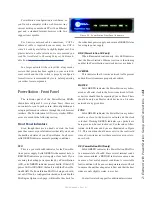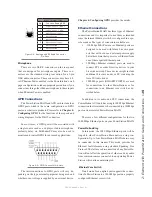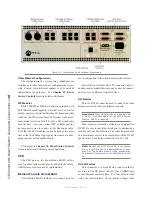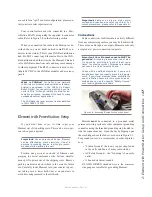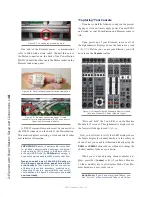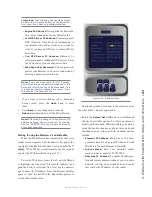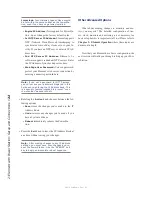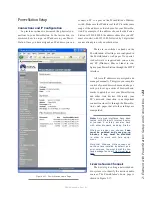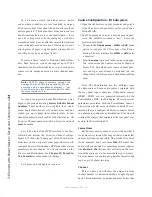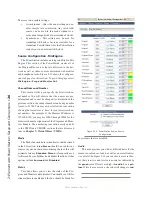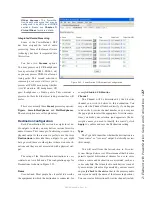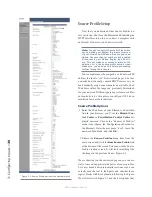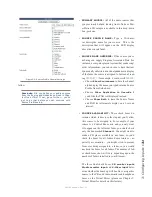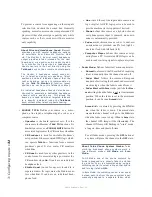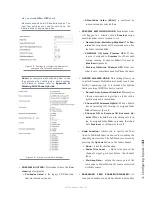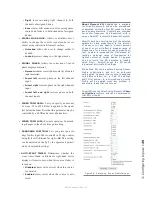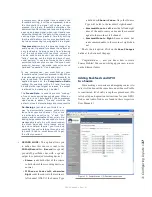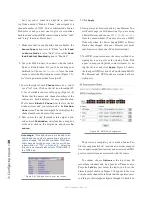
2: E
le
m
en
t w
ith P
ow
er
S
ta
tio
n: S
et
up a
nd C
on
ne
ct
io
ns •
2
7
©2016 Axia Audio- Rev 1.8.1
Other Sources: The PowerSta-
tion has other sources that may be
configured in its VMIX and VMODE
sections. Please see Chapter 7:
Virtual Mixer for more details.
Integrated Omnia Processing
Some of the PowerStation’s DSP
has been assigned the task of audio
processing. Some of the famous Omnia
technology has been incorporated into
this section.
You have two
Process
options:
You may process only CR headphones
for any selection (PGM-1, PGM-2, etc)
or you may process PGM-1 in all moni-
toring paths. This second selection is
commonly used since it allows you to
process all PGM-1 monitoring whether
it is CR monitors, CR headphones, CR
guest headphones or Studio guests. This simulates a
processed off-air feed that most radio personalities will
prefer.
There are currently three
Preset
processing options:
Bypass, SmoothHeadphones and HotHeadphones.
These descriptions are self-explanatory.
Destination Configuration
Each PowerStation I/O section has eight local au-
dio outputs to which you may deliver various Livewire
audio streams. This concept of delivering streams to a
physical output is the reason we prefer to use the term
Destinations
to describe these outputs. As you night
have guessed, there are other places where we use desti-
nations and they are not associated with a physical out-
put.
The setup of the PowerStation destinations is very
similar to an Axia 8x8 node. The configuration page for
Destinations is shown in Figure 2-20.
Name
User-defined. Most people fine it useful to describe
the equipment to which the destination is connected, for
example
Studio 4 CR Monitor
.
Channel
The Channel will be determined by the Livewire
channel you wish to deliver to this destination. You
may enter the Channel Number directly if you happen
to know the Livewire channel number or you may use
the pop-up box to select the appropriate Livewire source.
Once you make your selection (and appreciate the de-
scriptive name you used to identify the source!), click
Apply
to confirm and save the Destination setting.
Type
The Type field identifies whether the destination is a
“from source” or “to source” output. Lets briefly review
this concept.
You will recall from the Introduction to Livewire;
System Design Reference & Primer manual that Livewire
permits special bidirectional streams for use in cases
where a source and destination are associated, such as a
codec or hybrid. The return feed to such devices is usual-
ly a mix-minus (clean feed) generated by a mixer or mix
engine fed back to the device that is the primary audio
source (and usually the name of the stream in question).
You can create a bidirectional Livewire channel (includ-
Figure 2-20: PowerStation I/O Destination Configuration
Содержание element v.2.0
Страница 100: ...5 Element Operations 90 2016 Axia Audio Rev 1 8 1 Capital budget may you never decrease for we need new test gear...
Страница 149: ...Appendix A Specifications 139 2016 Axia Audio Rev 1 8 1...
Страница 183: ...Warranty 173 2016 Axia Audio Rev 1 8 1 TCP IP How did we live without thee Analogicly...
Страница 184: ...THIS PAGE INTENTIONALLY LEFT BLANK...
Страница 185: ...THIS PAGE INTENTIONALLY LEFT BLANK...

